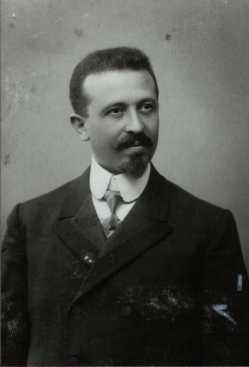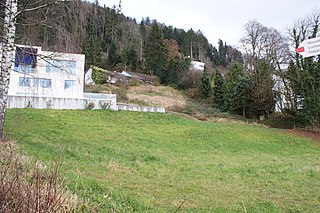
Eugen Zardetti (27 November 1849, Rorschach - 21 February 1926, Lucerne) was a Swiss portrait and marine painter. He was also an early automobile owner.

Eugen Zardetti (27 November 1849, Rorschach - 21 February 1926, Lucerne) was a Swiss portrait and marine painter. He was also an early automobile owner.
His father, Eugen, and mother Annette (née Von Bayer) were from an upper-class family that dealt in various colonial goods. He graduated from the Stella Matutina in Vorarlberg. Having displayed an early aptitude for art, he studied at the University of Innsbruck for a time, then switched to the Polytechnikum in Zürich where he studied with the architect Gottfried Semper. [1] After stays in Geneva and Lucerne, he attended the Academy of Fine Arts, Karlsruhe. [2] His artistic education was completed with study trips to Paris, Italy, and along the east coast of Africa.
After 1885, he was able to purchase a small mansion, the "Villa Mirador", in Bregenz (now a residence for a local gymnasium) and decided to specialize in marine painting. His best known work is, perhaps, a monumental panorama of the Battle of Lepanto. He also did maritime-themed paintings at the Gemäldegalerie and the Hoftheater in Dresden, the Rathaus in Winterthur and structures around the Ringstraße in Vienna. [1]
From 1914, after the beginning of World War I, he lived in Lucerne. [3]
He was also interested in technology and was the owner of the first industrially-produced automobile in Austria; a three-wheeled Benz Patent-Motorwagen. In 1898, he had it rebuilt as a four-wheeler. After his death, it was acquired by the Vienna Technical Museum where it still remains. Until 1896, Zardetti was the only automobile owner in Vorarlberg. [4] When he purchased the vehicle in 1893, he began a diary related to it, which was donated, together with some of his paintings, to the Vorarlberger Landesbibliothek in 2007. [5]

His older brother, Otto Zardetti, served as the Archbishop of Bucharest. One of his nieces was the author Lilly Braumann-Honsell , who owned the first steam yacht on Lake Constance.

CarlFriedrich Benz was a German engine designer and automotive engineer. His Benz Patent Motorcar from 1885 is considered the first practical modern automobile and first car put into series production. He received a patent for the motorcar in 1886, the same year he first publicly drove the Benz Patent-Motorwagen.

Vorarlberg is the westernmost state of Austria. It has the second-smallest geographical area after Vienna and, although it also has the second-smallest population, it is the state with the second-highest population density. It borders three countries: Germany, Switzerland, and Liechtenstein. The only Austrian state that shares a border with Vorarlberg is Tyrol, to the east.

Aaron Tänzer was a rabbi in Austria and Germany, chaplain and author.

Wettingen-Mehrerau Abbey is a Cistercian territorial abbey and cathedral located at Mehrerau on the outskirts of Bregenz in Vorarlberg, Austria. Wettingen-Mehrerau Abbey is directly subordinate to the Holy See and thus forms no part of the Catholic Archdiocese of Salzburg. The abbot of Wettingen-Mehrerau, however, is a member of the Austrian Bishops' Conference. The official name of the abbey is Beatae Mariae Virginis de Maris Stella et de Augia Majore.

John Joseph Frederick Otto Zardetti was a Swiss prelate of the Roman Catholic Church. He first served as the first bishop of the new Diocese of Saint Cloud in Minnesota in the United States from 1889 to 1894. Zardetti then served as Archbishop of the Archdiocese of Bucharest in what is today Romania from 1894 to 1895. After resigning as archbishop, Zardetti briefly, but influentially served in the Roman Curia with the title of titular archbishop of Mocissus.

Lohner–Porsche is a term encompassing several electric vehicles designed by Ferdinand Porsche and manufactured at Lohner-Werke in the early 1900s. They include the first hybrid electric vehicle and the first commercial hub motor car. The hybrid "Mixed" or "Mixte" racecars are powered by a gasoline engine which drives four electric motors, one in each wheel hub. The battery-powered "Touring" or "Chaise" commercial cars utilize only two front-wheel hub motors.
Adolf Herz was an Austrian-Swiss engineer and inventor. He co-designed one of the first modern blood pressure monitors.

Villa Maund is a villa in Schoppernau, Hopfreben in Vorarlberg, Austria, built for Sir John Oakley Maund between 1891 and 1895.

Norbert Brunner is an Austrian object, conceptual and installation artist.

Richard Alfred Eugen Jettel was a painter, producing mainly landscapes. He was from Austria-Hungary. He studied at the Vienna Academy and moved to Paris in 1873, before moving back to Vienna in 1897 and serving as a co-founder of the Vienna Secession. He was made a Knight of the Légion d'honneur in 1898.

Johann Gebhard Flatz was an Austrian painter of the Nazarene movement.

Wendelin Moosbrugger, or Mosbrugger was an Austrian portrait painter and miniaturist. He came from a family that had a widespread reputation as builders, plasterers and painters.

Kaspar Albrecht was an Austrian architect and sculptor.

Karlheinz Rüdisser is an Austrian politician for the Austrian People's Party (ÖVP), who, since December 2011, is the state administrator of Vorarlberg.
Eva Maria Waibel is an Austrian high school teacher and former politician for the Austrian People's Party (ÖVP). Waibel was, from May 1995 to October 2000, the regional minister of the provincial government of Vorarlberg.

José Ignacio Martínez is a photographer from Navia, Asturias, Spain who is specialized in architecture photography. Since he was a child Martínez was connected to photography through his contact with amateur and professional photographers, including his father, Jesús Martínez, a doctor, historian and photographer. (Gea, J.C., Donde habita la belleza, La Nueva España, 12 de julio de 2009, retrieved 19 December 2016). These experiences allowed him to learn how to handle various manual cameras, like the mythical Nikon F, and learned the use and tricks of the dark room, the enlarger, the chemical used in processing and other methods used on that time.
Ignaz Alois Anton von Indermauer zu Strelburg und Freifeld was an Austrian nobleman from Tyrol who served as the Landvögte and Kreishauptmann of Vorarlberg from 1791 until his death in 1796.
Otto Probst was an Austrian political activist. He survived World War II, despite spending most of it in the Buchenwald concentration camp, followed by two years in a punishment battalion sent to support the war effort on the Russian front. After 1945 he became a mainstream Social Democratic politician, eventually serving between 1970 and his death in 1978 as Third President of the National Council ("Nationalratspräsident").

At the lot Galgenbihl, a former place of executions in Bregenz was the location where in earlier times people of Vorarlberg, Austria, convicted in the County of Bregenz, were executed. Synonyms in German to name such a place are e.g. Richtstätte, Richtplatz and Richtstatt, all words implying a place combined with judgement, in German: richten.

Carl Emil Rudolf Ludwig Becker was a German marine artist.
![]() Media related to Eugen Zardetti at Wikimedia Commons
Media related to Eugen Zardetti at Wikimedia Commons